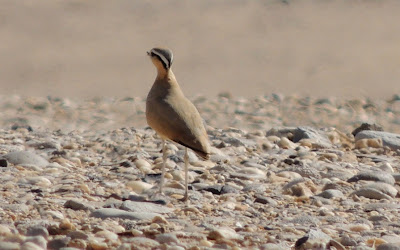I'd like to thank the company and especially Abdulaziz and Farhan Khan for arranging this. It is much appreciated. It was good to meet Farhan in person too.
The farm is 270 kilometres drive from Riyadh travelling through Kharj and then out eastward.
The highway called route 90 is a major green corridor in central Arabia and Haradh is at the far eastern side of the corridor.
black crowned sparrow lark
Even before we got inside NADEC we came across a female blue rock thrush resting on the perimeter fence.
Within the NADEC confines there are several individual farms separated by more natural terrain which is semi desert.
These semi desert areas were rich in larks. Indeed early on we drove through a place which had a large flock of black crowned sparrow lark.
female blue rock thrush
Crested lark could also be heard and seen. Hoopoe lark were not uncommon either.
hoopoe lark
The scattered bushes and trees in these areas were crowded with Spanish sparrow.
I was a little surprised how many of them had made it this far south and east for the winter.
Spanish sparrow
In the pivot fields were more crested lark and also desert wheatear and Isabelline wheatear though many fields had such tall and rich fodder it was difficult to see birds.
desert wheatear
We came upon a single Siberian stonechat on one of the pivot bars.
Siberian stonechat
The two types of eagle were seen greater spotted eagle and steppe eagle but only one of both.
Greater spotted eagle
The greater spotted eagle was seen from the main road before we arrived at the dairy and the steppe eagle was seen later flying over a field within the dairy.
Steppe eagle in flight
In many pivot fields in Saudi Arabia you can see a kestrel. NADEC at Haradh was no exception.
kestrel
Asian grey shrike
Two types of shrike were also observed, once again there was only one of each. There was a single Turkestan shrike and a single Asian grey shrike. I could not tell whether it was aucheri sub species or pallidirostris. Pallidirostris normally doesn't has the black mask going over the bill and this bird doesn't and a pink wash which this bird does making me edge towards Pallidirostris.
Until recently the sub species mattered a lot because aucheri was placed in a species called southern grey shrike and pallidirostris was placed in steppe grey shrike. However recent DNA work has found that these two sub species are more closely related to each other than any other sub species. So some fast moving authorities such as Dutch birding now call them collectively Asian grey shrike. It has certainly made our job in the field easier and instances like this more explainable.
water run off lake
Apart form the natural semi-desert and the fodder fields, the third main habitat in NADEC is wetland produced by run off from the cattle farming areas.
We visited two of these. In one the water was more processed than in the other. Ironically perhaps, the wetland with the less processed water had more diversity.
black winged stilt
Both wetlands had plenty of black winged stilt, common ringed plover and green sandpiper, little stint,Temminck's stint and white wagtail. Kentish plover were seen at the first wetland too.
wood sandpiper
The second wetland had more diversity with spur winged lapwing, common snipe and wood sandpiper present in good numbers.
spur winged lapwing
Two bluethroat were also observed, one at each wetland.
wagtails
Following on from the sighting of yellow wagtail at the golf course at KAUST, 1100 kilometres way last weekend, two were seen here as well.
cream coloured courser
As we headed out of the complex, we came across two cream coloured courser one of the semi desert areas. This was a lifer for Lou and the second time I had seen them in two weeks, a frequency I am unlikely to repeat.
This was a fitting end to our visit to NADEC.
Once again I would like to express my gratitude to the company.
List of birds seen at NADEC compiled by Lou Regensmorter:
Once again I would like to express my gratitude to the company.
List of birds seen at NADEC compiled by Lou Regensmorter:
Black Kite
|
Turkestan Shrike
|
Pallid Harrier
|
Asian Grey Shrike (aucheri)
|
Common Kestrel
|
Brown Necked Raven
|
Greater Spotted Eagle
|
Black-crowned Sparrow Lark
|
Moorhen
|
Greater Hoopoe Lark
|
Cream-coloured Courser
|
Crested Lark
|
Black-winged Stilt
|
Bluethroat
|
Spur-winged Lapwing
|
Siberian Stonechat
|
Common Ringed Plover
|
Isabelline Wheatear
|
Common Snipe
|
Desert Wheatear
|
Wood Sandpiper
|
Blue Rock Thrush
|
Green Sandpiper
|
House Sparrow
|
Common Sandpiper
|
Spanish Sparrow
|
Little Stint
|
White Wagtail
|
Temminck's Stint
|
Yellow Wagtail
|
Eurasian Collared Dove
|
Tawny Pipit
|
Namaqua Dove
|
Steppe eagle
|

















Why don't they lump the GGS together, Dutch Birding can publish a guide and call it......50 shades of Great Grey!......
ReplyDeleteLaurie -
Laurie,
ReplyDeleteVery, very funny! I do think the DNA folk are nearly there. It was the detours such as southern grey shrike which was invented before DNA analysis got good that have caused the credibility gap
rob
Robert, sorry but I could not find an email address for you!
ReplyDeleteI am a birder from Ireland doing occasional work in KSA. I am there next week, in Jeddah. By any chance do you know if there are any birders in the Jeddah area whom I could potentally contact for a few hours birding?
Many thanks
Wilton Farrelly
(wilton.farrelly@live.co.uk)
Wilton, I have replied by email. Hope it goes well in Jeddah.
ReplyDeleteRob